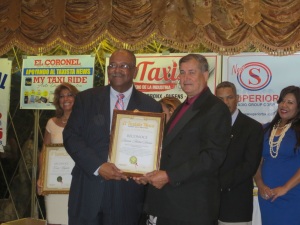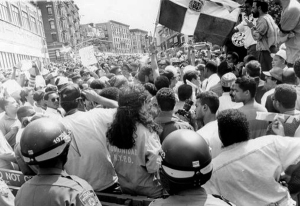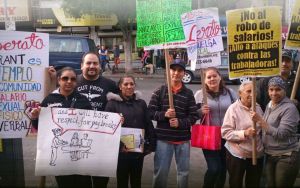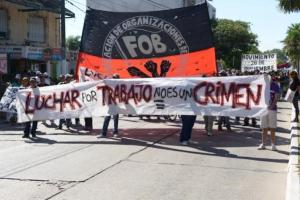Part Four: Engaging Autonomous Movements
Autonomists’ Orientation Toward Autonomous Movements
In the first three sections of this article, we’ve talked about a number of movements throughout the world that are called autonomous movements. We’ve noted that these movements, while an international phenomenon, have a particular preponderance in Latin America. We’ve noted that these movements are based on the self organization of working people, and we’ve discussed the fact that, as history might have lead us to expect, that self organization has yielded enormous contradictions alongside enormous potential. It has created, rather than a coherent program, a space where different ideologies struggle to define the movement’s direction. Some of these ideologies arise directly from the political experiences of the people whose interests are involved (like, for instance, the Federacion Argentina de Cooperativas de Trabajadores Autogestionados); others are imposed on the movement by outside forces, like mainstream or left wing political parties. We’ve seen that these ideologies are associated with different currents within movements—some frankly revolutionary, others reformist; some directly democratic, others authoritarian or bureaucratic.
We’ve also seen, however, that in spite of their complexities and contradictions, the autonomous movements in Latin America have involved millions of people across the continent in class struggle. They have engaged in expropriations, armed struggle, industrial struggle, and autonomous management of resources. They have directly confronted global capitalism and popularized an inflexible rhetoric of resistance. In addition, large sections of them have explicitly rejected political parties and clientelist relationships with them, and all of them have employed directly democratic methods of organization. As anarchists, libertarian communists, or autonomists, we cannot afford to be on the sidelines of these types of movements. We need to ask ourselves: what should our position be in relation to them?, and what significance do they have for the revolutionary currents in general, both locally and globally?
In the broadest terms, to give our view about the second question first, the different manifestations of autonomy throughout the world represent the best opportunity in decades for a really liberatory revolutionary movement, directed by working people, and support for and participation in them must be the absolute crux of our practice. And this leads us to our answer to the first question, which is that we believe we need to be in the best position possible to support those elements within autonomous movements that most tend towards working class autonomy. That means knowing something about the internal politics of autonomous movements and maintaining contact with those currents whose positions we can most wholeheartedly support, while at the same time carrying on a dialogue with all of the tendencies within a given movement—remembering always that, even if we don’t agree, these are our people, working people, and dialogue with our own class is always worthwhile. We take our hats off to groups like the Federacion de Organizaciones de Base in Argentina, which work among MTDs and other popular organizations; and we give our reluctant respect to the many Trotskyist groups, from FRETECO in Venezuela to Polo Obrero in Argentina, that have recognized the need to actually struggle for their own vision among these movements rather than eulogizing them from afar as some kind of primitive expression of autogestión. These are spaces where class struggle can take place and is taking place among working people already experienced in militancy, spaces where our adversaries, from Stalinists to fascists, are working to obtain influence—and as such they are spaces where we need to be present.
Autonomy at Home
One of the great flaws of autonomists located in the United States is that we tend to be far-sighted. It’s as easy it is ineffectual to function as cheerleaders for autonomous movements in Latin America, without acknowledging and attempting to confront their contradictions and their complexity. If we do this we are not only guilty, as noted above, of romanticizing movements which are flawed in many ways, and abandoning our true comrades within them—we are also guilty of ignoring the potential for and the reality of autonomous working class and oppressed peoples’ self-activity right under our eyes, in our own cities and neighborhoods.
Workers’ self-organization is a response to the universal pressure exercised by capitalism, imperialism, and the state, and it is constantly manifesting in different ways. These manifestations can range from church groups (like those that lead the “poblada”, the popular response to the Dominican government’s IMF deal in 1984) to street gangs (like those which have recently declared a truce in Baltimore in order to work together to resist police violence). Here in Washington Heights there are more than 90 “voluntary organizations”—sport clubs, cultural organizations, community service organizations, dominoes clubs. As is the case with popular self-organization throughout Latin America, there are a variety of tendencies represented in these organizations; some are right wing and nationalist, founded by Balaguer’s followers during the years of his exile in New York; others are reformist and have tended to move toward incorporation and institutional organizing. The vast majority of these organizations, however, are entirely working class in their composition. They are not “Community Based Organizations” or NGOs, and they fund their projects through fundraising activities and the voluntary contributions of members. Many of them were founded during the first wave of Dominican migration after the revolution of April 1965, and the level of political consciousness among their members is remarkable.

The editor of El Taxista News receives an award: working class social clubs and livery bases have their own spaces, newspapers, and other resources
Coexisting with these clubs, and sharing members and social space with them, is a network of livery taxi bases, virtually all of which began as worker-owned cooperatives, employing more than 30,000 drivers around the city. Again, the founders of many of these bases were anti-Balagueristas who arrived in New York fleeing either political or economic threats to their well being. These bases have ample experience of struggle, based on the fact that about half of their income comes from a source that is against the law in New York City—picking up passengers who hail them on the street. Their drivers have been subjected to years of harassment by the police and the Taxi and Limousine Commission; laws have been designed to divide and disorganize them (the most recent being the introduction of Green or Borough Cabs); and concerted efforts have been made by the yellow cab industry to eliminate altogether this source of unwanted competition. Washington Heights’ taxi drivers have nevertheless managed to publish their own newspapers, organize their own sports leagues, and purchase buildings to provide cooperative apartments for their drivers.

Washington Heights has a long history of militance: the neighborhood exploded when police killed Kiko Garcia in 1992
In addition to relatively formal popular organizations like clubs and taxi bases, upper Manhattan is permeated with informal working class self-directed activity. Sans, or sociedades, informal credit associations among neighbors or co-workers, have been crucial to the founding of the many business enterprises which helped keep Washington Heights from the same fate of abandonment and depopulation that the South Bronx met with in the 1970s. Short lived mothers’ groups focused on school issues and against violence have been a familiar part of the working class social landscape—and are particularly significant given the dearth of female participation in most taxi bases and social clubs. Finally, the neighborhood has a history of popular resistance. Dominican student groups participated in the fight for community control of George Washington High School and other schools; Dominican immigrants living in Washington Heights, some with close ties to livery cab bases, were one of the driving forces behind the strikes at CUNY in 1989 and 1991; and anti-police riots rocked Washington Heights after the shooting of 24 year old Kiko Garcia on July 3, 1992.
Our Orientation
There are those who claim that, in engaging working class autonomous movements in dialogue, we are compromising their autonomy—that we are an outside force, and that we shouldn’t interfere. While we respect the impulse to defend working class autonomy, we have several objections to the “noninterference” argument. To begin with, we aren’t interfering, as such—we are working people, and what happens to autonomous movements and organizations in Washington Heights or Buenos Aires affects us, our lives, and our future. Apart from this, we have a greater respect for the political preparation and self-activity of the working class than to believe that our “interference” will unduly influence the course of events if it doesn’t correspond to positions that at least some working people already hold. We want our ideas to be a part of the discourse around self-organization, and above all we want to work to make the defense of autonomy itself a conscious undertaking. In Washington Heights (though not, certainly, in Buenos Aires) there is working class autonomous self-organization without a corresponding ideology of autonomy. If we don’t “interfere” by emphasizing the significance of that autonomous self-organization, if we don’t align ourselves with the elements that want to defend their class autonomy, we can be sure of one thing: authoritarians and opportunists will be actively working to coopt those elements. The same working class clubs that could form the basis of an autonomous movement are constantly courted by political parties both local and Dominican, and many of the livery cab cooperatives have begun selling out to private owners. We should also remember that after the 1992 riots, Washington Heights was flooded with social spending, but it didn’t benefit the people who risked their safety in the street battling the NYPD, but rather the local politicians and their client NGOs (Charles Rangel, through Alianza Dominicana and Guillermo Linares, through the Asociacion Comunitaria de Dominicanos Progresistas, for example).

Taxi drivers and other community members have supported the labor campaign against Liberato Restaurant
If our approach to autonomous movements is to be one of active engagement with them, including supporting the currents in them which espouse autonomy as an ideology, and dialogue with those genuine working class elements which do not, what does that mean in practical terms? Washington Heights social club members may not go out and stand on a picket line—although we shouldn’t discount a long history of militant work actions by Dominican taxistas who have blocked roads and bridges on numerous occasions. But livery cab drivers have reacted favorably to a campaign by Nosotros los Pobres asking them to boycott a Bronx restaurant, Liberato, whose workers are protesting against wage theft and sexual harassment. Clubs, meanwhile, possess that most precious commodity in the contracting environment of upper Manhattan—space, space where presentations can be made, where workshops can be held, where literature can be distributed. A club associated with the High Class livery base, for example, gave Laundry Workers Center a space to hold a workshop on wage theft. These steps toward engagement should only be a beginning. Working class organizations in Washington Heights bring together cohesive groups of working people who can be engaged in dialogue and who can contribute experience, information, ideas, and an intimate knowledge of local political history. They could potentially use their resources for any number of projects that would benefit them and their community, from re-constituting driver co-ops with their own ride sharing apps in conjunction with labor unions, as taxi drivers have recently done in Denver, to leveraging financing for limited equity co-ops that could bring a halt to the displacement, the way the Amalgamated Garment Workers Union did in the Bronx in the 1930s and 1960s. These clubs, these bases, these sans and informal mothers’ groups, are precious resources, and we are willing to bet that the working class has created similar autonomous institutions in the neighborhoods where every one of our readers live. If we don’t take advantage of their existence, they will be gentrified out of Washington Heights along with everything else.
These are the first three sections of this article:
https://nosotroslospobres.wordpress.com/2014/11/13/defining-autonomy/
https://nosotroslospobres.wordpress.com/2014/12/08/impact-of-autonomous-movements-part-two-of-three/
https://nosotroslospobres.wordpress.com/2015/01/22/complexities-of-autonomy-part-three-of-four/
